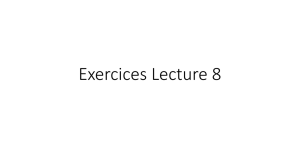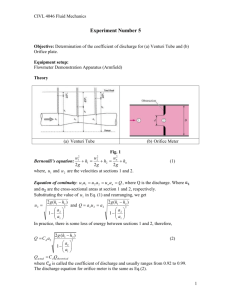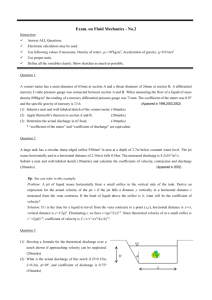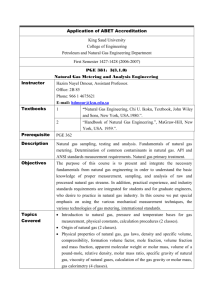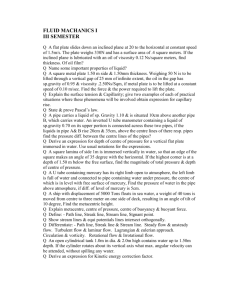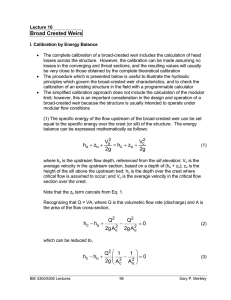Calib ration of Canal Gates
advertisement
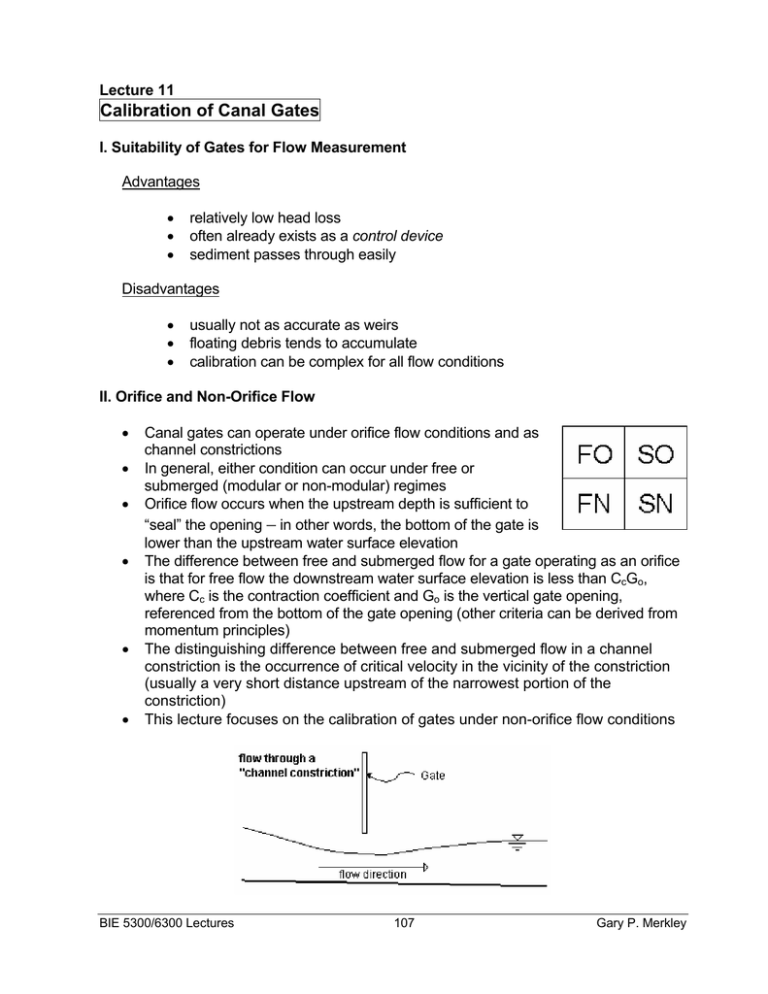
Lecture 11 Calibration of Canal Gates I. Suitability of Gates for Flow Measurement Advantages • • • relatively low head loss often already exists as a control device sediment passes through easily Disadvantages • • • usually not as accurate as weirs floating debris tends to accumulate calibration can be complex for all flow conditions II. Orifice and Non-Orifice Flow • • • • • • Canal gates can operate under orifice flow conditions and as channel constrictions In general, either condition can occur under free or submerged (modular or non-modular) regimes Orifice flow occurs when the upstream depth is sufficient to “seal” the opening − in other words, the bottom of the gate is lower than the upstream water surface elevation The difference between free and submerged flow for a gate operating as an orifice is that for free flow the downstream water surface elevation is less than CcGo, where Cc is the contraction coefficient and Go is the vertical gate opening, referenced from the bottom of the gate opening (other criteria can be derived from momentum principles) The distinguishing difference between free and submerged flow in a channel constriction is the occurrence of critical velocity in the vicinity of the constriction (usually a very short distance upstream of the narrowest portion of the constriction) This lecture focuses on the calibration of gates under non-orifice flow conditions BIE 5300/6300 Lectures 107 Gary P. Merkley III. Rating Open Channel Constrictions • • • • Whenever doing structure calibrations, examine the data carefully and try to identify erroneous values or mistakes Check the procedures used in the field or laboratory because sometimes the people who take the measurements are not paying attention and make errors Never blindly enter data into a spreadsheet or other computer program and accept the results at “face value” because you may get incorrect results and not even realize it Always graph the data and the calibration results; don’t perform regression and other data analysis techniques without looking at a graphical representation of the data and comparison to the results Free Flow • • Gates perform hydraulically as open channel constrictions (non-orifice flow) when the gate is raised to the point that it does not touch the water surface The general form of the free-flow equation is: n Qf = Cf hu f (1) where the subscript f denotes free flow; Qf is the free-flow discharge; Cf is the free-flow coefficient; and nf is the free-flow exponent • • The value of Cf increases as the size of the constriction increases, but the relationship is usually not linear The value of nf is primarily dependent upon the geometry of the constriction with the theoretical values being 3/2 for a rectangular constriction and 5/2 for a triangular constriction Sample Free-Flow Constriction Calibration • • Sample field data for developing the discharge rating for a rectangular openchannel constriction are listed in the table below The discharge rate in the constriction was determined by taking current meter readings at an upstream location, and again at a downstream location Gary P. Merkley 108 BIE 5300/6300 Lectures • This is a good practice because the upstream and downstream flow depths are often significantly different, so that the variation in the measured discharge between the two locations is indicative of the accuracy of the current meter equipment and the methodology used by the field staff Date 21 Jun 86 21 Jun 86 21 Jun 86 21 Jun 86 Discharge (m3/s) 0.628 1.012 1.798 2.409 Water Surface Elevation in Stilling Well (m) 409.610 409.935 410.508 410.899 Note: The listed discharge is the average discharge measured with a current meter at a location 23 m upstream of the constriction, and at another location 108 m downstream. • The free-flow equation for the flow depths measured below the benchmark (at 411.201 m) is: 1.55 Qf = 0.74 ( hu ) x Col. 1 Discharge (m3/s) 0.628 1.009 1.797 2.412 Col. 2 Water Surface Elevation (m) 409.610 409.935 410.508 410.899 Col. 3 (hu)sw (m) 0.918 1.243 1.816 2.207 Col. 4 Tape Measurement (m) 1.604 1.294 0.734 0.358 (2) Col. 5 (hu)x (m) 0.905 1.215 1.775 2.151 Notes: The third column values equal the values in column 2 minus the floor elevation of 408.692 m. The values in column 5 equal the benchmark elevation of 411.201 m minus the floor elevation of 408.692 m, minus the values in column 4. • • The “Tape Measurement” in the above table is for the vertical distance from the benchmark down to the water surface If a regression analysis is performed with the free-flow data using the theoretical value of nf = 3/2, 1.5 Qf = 0.73 ( hu )sw (3) or, 1.5 Qf = 0.75 ( hu ) x • (4) The error in the discharge resulting from using nf = 3/2 varies from -1.91% to +2.87%. BIE 5300/6300 Lectures 109 Gary P. Merkley Submerged Flow • The general form of the submerged-flow equation is: Qs = nf Cs ( hu − hd ) ns ( − logS ) (5) where the subscript s denotes submerged flow, so that Qs is the submerged-flow discharge, Cs is the submerged-flow coefficient, and ns is the submerged-flow exponent • • • • • Base 10 logarithms have usually been used with Eq. 5, but other bases could be used, so the base should be specified when providing calibration values Note that the free-flow exponent, nf, is used with the term hu - hd Consequently, nf is determined from the free-flow rating, while Cs and ns must be evaluated using submerged-flow data The theoretical variation in ns is between 1.0 and 1.5 Note that the logarithm term in the denominator of Eq. 5 can be estimated by taking the first two or three terms of an infinite series (but this is not usually necessary): loge (1 + x) = x − 1 2 1 3 1 4 x + x − x +… 2 3 4 (6) Graphical Solution for Submerged-Flow Calibration • • • • The graphical solution used to be performed by hand on log-log paper before PCs and programmable calculators became widely available This is essentially how the form of the submerged-flow equation was derived in the 1960’s This solution technique assumes that the free-flow exponent, nf, is known from a prior free-flow calibration at the same structure So, assuming you already know nf, and you have data for submerged flow conditions, you can plot Qs versus (hu – hd), as shown in the figure below where there are five measured points Gary P. Merkley 110 BIE 5300/6300 Lectures • • • • • • • • The above graph has a log-log scale The slope of the parallel lines is equal to nf, as shown above (measured using a linear, not log, scale), and each line passes through one of the plotted data points The five values of Qs at each of the horizontal dashed lines are for ∆h = 1.0 Get another sheet of log-log paper and plot the five Q∆h = 1.0 values versus log10S, as shown in the figure below Draw a straight line through the five data points and extend this line to –log10S = 1.0 (as shown above) The value on the ordinate at –log10S = 1.0 is Cs The slope of the line is –ns (measured with a linear scale) You might not prefer to use this method unless you have no computer BIE 5300/6300 Lectures 111 Gary P. Merkley Submerged-Flow Calibration by Multiple Regression • • Multiple regression analysis can be used to arrive directly at all three values (Cs, nf, and ns) without free-flow data This can be done by taking the logarithm of Eq. 5 as follows: logQs = logCs + nf log ( hu − hd ) − ns log ( − logS ) • • • • • (7) Equation 7 is linear with respect to the unknowns Cs, nf, and ns Such a procedure may be necessary when a constriction is to be calibrated in the field and only operates under submerged-flow conditions You can also compare the calculated nf values for the free- and submerged-flow calibrations (they should be nearly the same) Spreadsheet applications and other computer software can be used to perform multiple least-squares regression conveniently This method can give a good fit to field or laboratory data, but it tends to complicate the calculation of transition submergence, which is discussed below Sample Submerged-Flow Constriction Calibration • • • • In this example, a nearly constant discharge was diverted into the irrigation channel and a check structure with gates located 120 m downstream was used to incrementally increase the flow depths Each time that the gates were changed, it took 2-3 hours for the water surface elevations upstream to stabilize Thus, it took one day to collect the data for a single flow rate The data listed in the table below were collected in two consecutive days Date 22 Jun 86 22 Jun 86 22 Jun 86 22 Jun 86 22 Jun 86 23 Jun 86 23 Jun 86 23 Jun 86 23 Jun 86 23 Jun 86 Gary P. Merkley Discharge (m3/s) 0.813 0.823 0.825 0.824 0.793 1.427 1.436 1.418 1.377 1.241 Tape Measurement from U/S Benchmark (m) 1.448 1.434 1.418 1.390 1.335 0.983 0.966 0.945 0.914 0.871 112 Tape Measurement from D/S Benchmark (m) 1.675 1.605 1.548 1.479 1.376 1.302 1.197 1.100 1.009 0.910 BIE 5300/6300 Lectures Qs (m3/s) 0.813 0.823 0.825 0.824 0.793 1.427 1.436 1.418 1.377 1.241 • • • • (hu)x (m) 1.061 1.075 1.091 1.119 1.174 1.526 1.543 1.564 1.595 1.638 (hd)x (m) 0.832 0.902 0.959 1.028 1.131 1.205 1.310 1.407 1.498 1.597 S -log10S Q∆h=1 0.784 0.839 0.879 0.919 0.963 0.790 0.849 0.900 0.939 0.975 0.1057 0.0762 0.0560 0.0367 0.0164 0.1024 0.0711 0.0458 0.0273 0.0110 7.986 12.486 19.036 33.839 104.087 8.305 13.733 25.005 51.220 175.371 A logarithmic plot of the submerged-flow data can be made Each data point can have a line drawn at a slope of nf = 1.55 (from the prior freeflow data analysis), which can be extended to where it intercepts the abscissa at hu - hd = 1.0 Then, the corresponding value of discharge can be read on the ordinate, which is listed as Q∆h=1.0 in the above table The value of Q∆h=1.0 can also be determined analytically because a straight line on logarithmic paper is an exponential function having the simple form: nf Cs (hu − hd ) Qs = Q∆h=1 ( − logS )ns n Cs (1) f ( − logS )ns nf = (hu − hd ) (8) then, nf Qs = Q∆h=1.0 (hu − hd ) (9) or, Q∆h=1.0 = Qs (10) nf (hu − hd ) where Q∆h=1.0 has a different value for each value of the submergence, S • Using the term Q∆h=1.0 implies that hu - hd = 1.0 (by definition); thus, Eq. 10 reduces to: BIE 5300/6300 Lectures 113 Gary P. Merkley Q∆h=1.0 = • • • nf Cs (1.0 ) nf (hu − hd ) = Cs ( − logS ) −ns (11) Again, this is a power function where Q∆h=1.0 can be plotted against (-log S) on logarithmic paper to yield a straight-line relationship Note that the straight line in such a plot would have a negative slope (-ns) and that Cs is the value of Q∆h=1.0 when (-log S) is equal to unity For the example data, the submerged-flow equation is: 1.55 Qs = 0.367 ( hu − hd ) (12) 1.37 ( − logS ) Transition Submergence • • By setting the free-flow discharge equation equal to the submerged-flow discharge equation, the transition submergence, St, can be determined Consider this: Cf hnuf n = Cs (1 − St ) f hnuf (13) ns ( − logSt ) then, ns f ( St ) = Cf ( − logSt ) • nf − Cs (1 − St ) =0 (14) In our example, we have: 1.37 0.74 ( − logS ) 1.55 = 0.367 (1 − S ) (15) or, 0.74h1.55 u 1.55 = 0.367 ( hu − hd ) (16) ( − logS )1.37 and, 1.37 0.74 ( − logS ) • • 1.55 = 0.367 (1 − S ) (17) The value of S in this relationship is St provided the coefficients and exponents have been accurately determined Again, small errors will dramatically affect the determination of St Gary P. Merkley 114 BIE 5300/6300 Lectures 1.37 0.74 ( − logSt ) • • • 1.55 = 0.367 (1 − St ) (18) Equation 18 can be solved to determine the value of St, which in this case is 0.82 Thus, free flow exists when S < 0.82 and submerged flow exists when the submergence is greater than 82% The table below gives the submergence values for different values of Qs/Qf for the sample constriction rating S 0.82 0.83 0.84 0.85 0.86 0.87 0.88 0.89 0.90 Qs/Qf 1.000 0.9968 0.9939 0.9902 0.9856 0.9801 0.9735 0.9657 0.9564 S 0.91 0.92 0.93 0.94 0.95 0.96 0.97 0.98 - Qs/Qf 0.9455 0.9325 0.9170 0.8984 0.8757 0.8472 0.8101 0.7584 - 1.55 Qs 0.367 ( hu − hd ) = Qf ( − logS )1.37 = 1 0.74h1.55 u (19) which is also equal to: 1.55 Qs 0.496 (1 − S ) = Qf ( − logS )1.37 • For example, if hu and hd are measured and found to be 1.430 and 1.337, the first step would be to compute the submergence, S, S= • • • (20) 1.337 = 0.935 1.430 (21) Thus, for this condition submerged flow exists in the example open-channel constriction In practice, there may only be a “trivial” solution for transition submergence, in which St = 1.0. In these cases, the value of Cs can be slightly lowered to obtain another mathematical root to the equation. This is a “tweaking” procedure. Note that it is almost always expected that 0.50 < St < 0.92. If you come up with a value outside of this range, you should be suspicious that the data and or the analysis might have errors. BIE 5300/6300 Lectures 115 Gary P. Merkley IV. Constant-Head Orifices • • • • • • • • A constant-head orifice, or CHO, is a double orifice gate, usually installed at the entrance to a lateral or tertiary canal This is a design promoted for years by the USBR, and it can be found in irrigation canals in many countries The idea is that you set the downstream gate as a meter, and set the upstream gate as necessary to have a constant water level in the mid-gate pool It is kind of like the double doors in the engineering building at USU: they are designed to act as buffers whereby the warm air doesn’t escape so easily when people enter an exit the building But, in practice, CHOs are seldom used as intended; instead, one of the gates is left wide open and the other is used for regulation (this is a waste of materials because one gate isn’t used at all) Note the missing wheel in the upstream gate, in the above figure Few people know what CHOs are for, and even when they do, it is often considered inconvenient or impractical to operate both gates But these gates can be calibrated, just as with any other gate V. General Hydraulic Characteristics of Gates for Orifice Flow • • • • • It is safe to assume that the exponent on the head for orifice flow (free and submerged) is 0.50, so it is not necessary to treat it as an empirically-determined calibration parameter The basic relationship for orifice flow can be derived from the Bernoulli equation For orifice flow, a theoretical contraction coefficient, Cc, of 0.611 is equal to π/(π+2), derived from hydrodynamics for vertical flow through an infinitely long slot Field-measured discharge coefficients for orifice flow through gates normally range from 0.65 to about 0.9 − there is often a significant approach velocity Radial gates can be field calibrated using the same equation forms as vertical sluice gates, although special equations have been developed for them Gary P. Merkley 116 BIE 5300/6300 Lectures VI. How do You Know if it is Free Flow? • • • • • • If the water level on the upstream side of the gate is above the bottom of the gate, then the flow regime is probably that of an orifice In this case, the momentum function (from open-channel hydraulics) can be used to determine whether the flow is free or submerged In some cases it will be obviously free flow or obviously submerged flow, but the following computational procedure is one way to distinguish between free orifice and submerged orifice flow In the figure below, h1 is the depth just upstream of the gate, h2 is the depth just downstream of the gate (depth at the vena-contracta section) and h3 is the depth at a section in the downstream, a short distance away from the gate If the value of the momentum function corresponding to h2 is greater than that corresponding to h3, free flow will occur; otherwise, it is submerged The momentum function is: Q2 M = A hc + gA (22) where A is the cross-sectional area and hc is the depth to the centroid of the area from the water surface • The following table shows the values of A and Ahc for three different channel sections BIE 5300/6300 Lectures 117 Gary P. Merkley Section A Ahc Rectangular bh bh2 2 Trapezoidal ⎡ ⎛ m1 + m2 ⎞ ⎤ ⎟ h⎥ h ⎢b + ⎜ 2 ⎝ ⎠ ⎦ ⎣ ⎡ b ⎛ m1 + m2 ⎞ ⎤ 2 ⎟ h⎥ h ⎢2 + ⎜ 6 ⎝ ⎠ ⎦ ⎣ D3 4 D2 ( θ − sin θ ) 8 Circular ⎡ sin3 ( θ / 2 ) cos ( θ / 2 )( θ − sin θ ) ⎤ − ⎢ ⎥ 3 4 ⎢⎣ ⎥⎦ • • For rectangular and trapezoidal sections, b is the base width For trapezoidal sections, m1 and m2 are the inverse side slopes (zero for vertical sides), which are equal for symmetrical sections • For circular sections, θ is defined as: θ = 2cos −1 ⎛ 2h ⎞ ⎜1 − ⎟ D⎠ ⎝ where D is the inside diameter of the circular section • There are alternate forms of the equations for circular sections, but which yield the same calculation results. • The depth h2 can be determined in the either of the following two ways: 1. h2 = Cc Go where Cc is the contraction coefficient and Go is the vertical gate opening 2. Equate the specific energies at sections 1 and 2, where E =h+ Q2 2gA 2 , then solve for h2 • • Calculate M2 and M3 using the depths h2 and h3, respectively If M2 ≤ M3, the flow is submerged; otherwise the flow is free • Another (simpler) criteria for the threshold between free- and submerged-orifice flow is: CcGo = hd (23) where Cc is the contraction coefficient (≈ 0.61) Gary P. Merkley 118 BIE 5300/6300 Lectures • But this is not the preferred way to make the distinction and is not as accurate as the momentum-function approach VII. How do You Know if it is Orifice Flow? • The threshold between orifice and nonorifice flow can be defined as: Cohu = Go (24) where Co is an empirically-determined coefficient (0.80 ≤ Co ≤ 0.95) • • • • Note that if Co = 1.0, then when hu = Go, the water surface is on the verge of going below the bottom of the gate (or vice-versa), when the regime would clearly be nonorifice However, in moving from orifice to nonorifice flow, the transition would begin before this point, and that is why Co must be less than 1.0 It seems that more research is needed to better defined the value of Co In practice, the flow can move from any regime to any other at an underflow (gate) structure: Free Submerged Orifice FO SO Non-orifice FN SN VII. Orifice Ratings for Canal Gates • For free-flow conditions through an orifice, the discharge equation is: Qf = CdCv A 2ghu (25) where Cd is the dimensionless discharge coefficient; Cv is the dimensionless velocity head coefficient; A is the area of the orifice opening, g is the ratio of weight to mass; and hu is measured from the centroid of the orifice to the upstream water level BIE 5300/6300 Lectures 119 Gary P. Merkley • • The velocity head coefficient, Cv, approaches unity as the approach velocity to the orifice decreases to zero In irrigation systems, Cv can usually be assumed to be unity since most irrigation channels have very flat gradients and the flow velocities are low The upstream depth, hu, can also be measured from the bottom of the orifice opening if the downstream depth is taken to be about 0.61 times the vertical orifice opening Otherwise, it is assumed that the downstream depth is equal to one-half the opening, and hu is effectively measured from the area centroid of the opening The choice will affect the value of the discharge coefficient • If hu is measured from the upstream canal bed, Eq. 4 becomes • • • Qf = CdCv A 2g(hu − CgGo ) (26) where Cg is usually either 0.5 or 0.61, as explained above. • If the downstream water level is also above the top of the opening, submerged conditions exist and the discharge equation becomes: Qs = CdCv A 2g ( hu − hd ) (27) where hu - hd is the difference in water surface elevations upstream and downstream of the submerged orifice. • • • • • • An orifice can be used as an accurate flow measuring device in an irrigation system If the orifice structure has not been previously rated in the laboratory, then it can easily be rated in the field As mentioned above, the hydraulic head term, (hu - CgGo) or (hu - hd), can be relied upon to have the exponent ½, which means that a single field rating measurement could provide an accurate determination of the coefficient of discharge, Cd However, the use of a single rating measurement implies the assumption of a constant Cd value, which is not the case in general Adjustments to the basic orifice equations for free- and submerged-flow are often made to more accurately represent the structure rating as a function of flow depths and gate openings The following sections present some alternative equation forms for taking into account the variability in the discharge coefficient under different operating conditions Gary P. Merkley 120 BIE 5300/6300 Lectures VIII. Variation in the Discharge Coefficient • • Henry (1950) made numerous laboratory measurements to determine the discharge coefficient for free and submerged flow through an orifice gate The figure below shows an approximate representation of his data BIE 5300/6300 Lectures 121 Gary P. Merkley Gary P. Merkley 122 BIE 5300/6300 Lectures
